Over the last week I’ve had a lot of fun building a little retro-themed website that I’m hosting at home. Inspired by Ruben’s Retro Corner I’ve been meaning to do this for a while, and actually started on it in June last year. More recently Joel Humphries shared on The Sizzle forum that he’d built a little site that he was hosting at home on a Raspberry Pi. This reignited my interest in getting my own site up again. For the fun of it I decided to implement it in HTML4 and serve it over plain HTTP so that it would work on old computers.
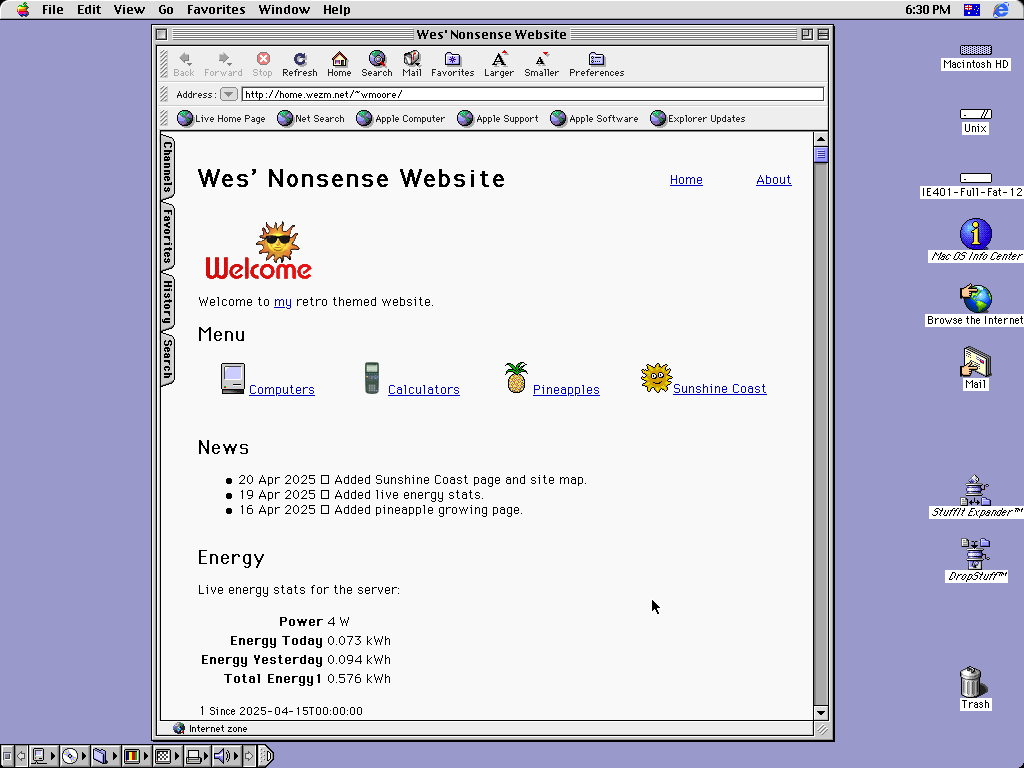
Website on a Microcontroller?
Sticking with the retro theme I initially thought it might be fun to host the site on an resource constrained device. So, on the first evening I put together a simple page hosted on a RISC-V ESP32-C3 microcontroller using bare-metal Rust (with the exception of some C libraries used for Wi-Fi support). This was fine, but felt a little too constrained, and there was some non-ideal behaviour of the http crate I used. Nonetheless I published the code to my git forge.
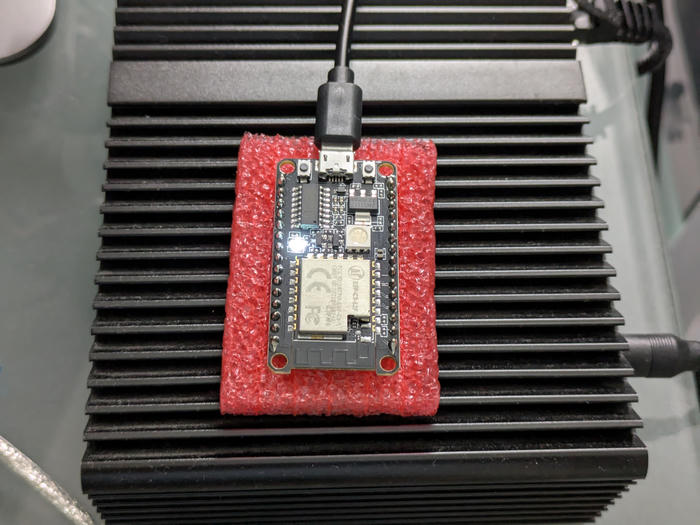
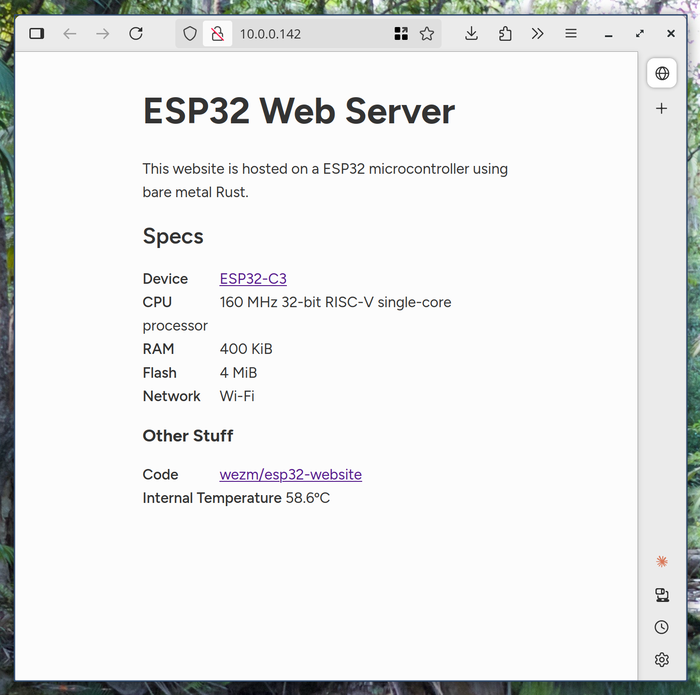
The Best Server Is the Server You Already Have
The next version I threw together went back to basics. Digging up my website building knowledge from university I constructed a two page site using HTML4, complete with 88×31 buttons. Akin to my university website I hosted it on a ~wmoore path:
This one was hosted by the mini fanless Qotom computer running
Chimera Linux already sitting on my desk. I wanted it to be slightly more
interesting than just static HTML so I included free and uptime information
about the server on the home page:
Update 30 May 2025: I migrated the hosting of the site to another fanless computer I had in a drawer today: a LattePanda V1 single-board computer. See the about page for more info.
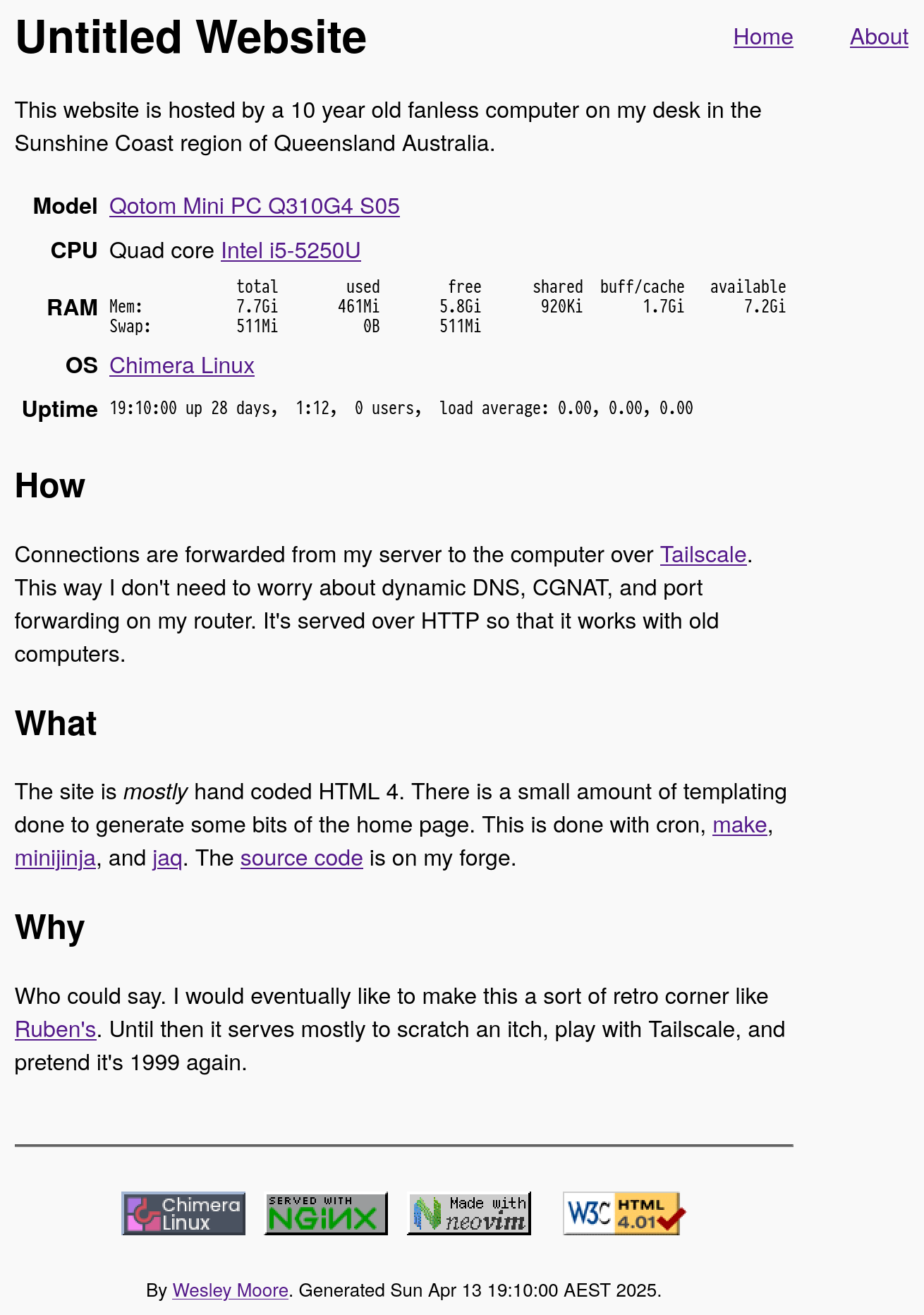
I used the MiniJinja CLI, jaq, and make to regenerate the static HTML from templates, funnelling the dynamic content into a JSON file.
# minijinja-cli creates files with 600 perms, due to using a tempfile
# library to generate output. Fixed in main, but not released yet.
public/about.html: about.j2 data.json
minijinja-cli $^ -o $@
chmod 644 $@
public/index.html: index.j2 data.json
minijinja-cli $^ -o $@
chmod 644 $@
data.json: memory.json uptime.json generated.json
cat $^ | jaq -s add > $@
memory.json:
free -h | jaq -Rs '{memory: .}' > $@
uptime.json:
uptime | jaq -Rs '{uptime: .}' > $@
generated.json:
date | jaq -Rs '{generated: .}' > $@
To get the site online I made use of Tailscale. This allowed me to avoid
dealing with port forwarding on my Wi-Fi router, Dynamic DNS, and things like
that. The server hosting the page you are reading now (a VPS with
Vultr(affiliate link)) uses Nginx to reverse proxy to the
Tailscale IP of the Qotom server. Nginx on the Qotom serves the website. I set
up a cron job to run make and regenerate the dynamic content every 5 minutes.
Internet
│
│
│
┌─────────────────────┐
│ │
│ Vultr Server │
│ │
│ ┌─────────────┐ │
│ │ nginx │ │
│ └─────────────┘ │
│ ┌──┐ │
└────────│──│─────────┘
│ │
│ │ Tailscale
│ │
┌───────────────────────────────┐
│ │ │ │
│ ┌────────│──│─────────┐ │
│ │ └──┘ │ │
│ │ ┌─────────────┐ │ │
│ │ │ nginx │ │ │
│ │ └─────────────┘ │ │
│ │ │ │
│ │ Qotom │ │
│ │ │ │
│ └─────────────────────┘ │
│ │
│ Home Network │
│ behind Router │
│ │
└───────────────────────────────┘
What if I Used CGI Instead?
This was fine, but I didn’t like the idea that regenerating the site every five
minutes was causing unnecessary writes to the disk. It’s just a cheap 32Gb
mSATA drive, and is the second one this machine has used over its lifetime.
For more retro nostalgia I thought it would be neat to generate the dynamic
content with Common Gateway Interface (CGI) scripts, served from cgi‑bin of
course.
I tinkered with this but in the end decided not to use actual CGI. Firstly, Nginx doesn’t support it, only FastCGI. Secondly it complicated development as it required a dev server that supported CGI and static file hosting. The best/closest option I found was Lighttpd, but this all seemed harder than it needed to be.
I fell back on the more modern approach of having web applications talk HTTP
directly behind a proxy. I put together a small Rust server with Axum.
Sticking the with theme though, the dynamic pages are served on paths like
cgi-bin/about.cgi. In development the Rust binary serves the static files
and dynamic pages. In a release build it only serves dynamic content and
Nginx does the static files.
The Joy of HTML4
Here’s where the fun really began. I thoroughly enjoyed filling out the pages on what was now known as “Wes’ Nonsense Website”—nonsense in the extravagant foolishness or frivolity sense. It was genuinely fun to write about growing pineapples, include pixelated GIF icons, and the odd animated GIF.
Coding in HTML4 Transitional is somewhat freeing. CSS is great, but it’s large and sprawling. Throwing that away and sticking to only what you can achieve with a comparatively small set of HTML tags and their attributes dramatically reduces the scope of things. Also feels a bit cheeky to mix content and style with wild abandon.
It wouldn’t be the classic web without feeding your pages through the W3C Validator. Amazingly the validator still accepts and validates HTML4. The checks were useful for finding messed up closing tags and other mistakes.
Now part of the reason to use HTML4 and serve the site over plain HTTP is so that it has a chance of working on old computers. As I was building the site I continually tested it in Internet Explorer 4.01 and Netscape Navigator 3.01 running in Mac OS 8.1 in the Basilisk II 68k emulator.
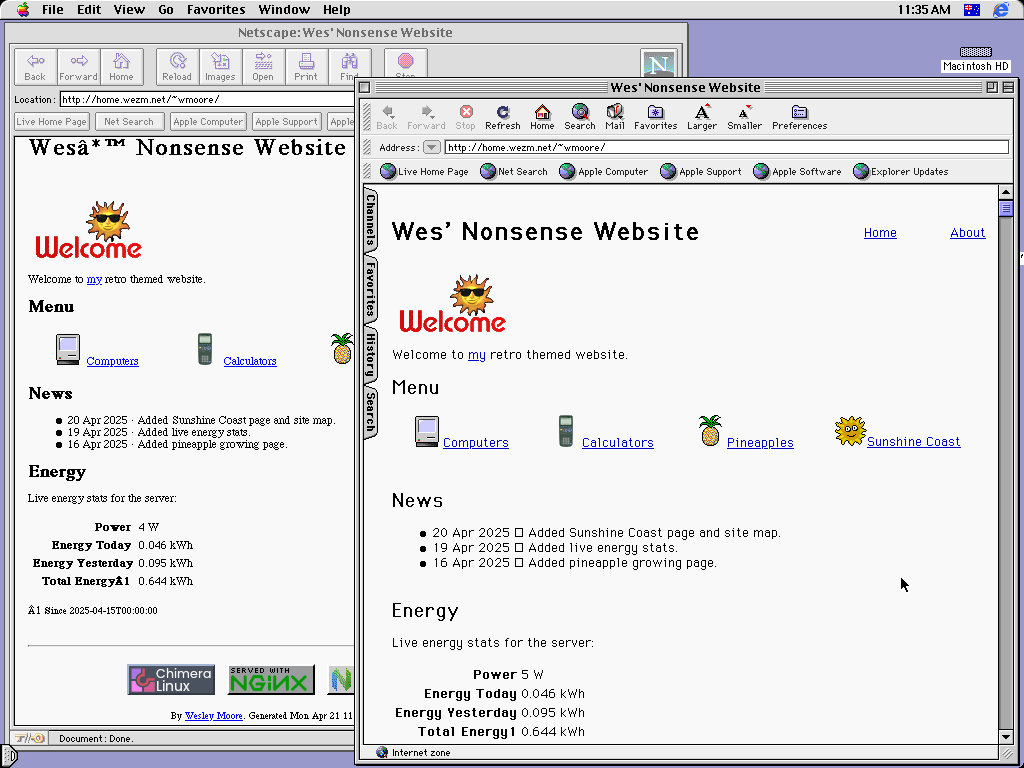
These posed some unique challenges, mostly around text encoding. The content is
authored and served as UTF-8, but this was only supported by version 4 onwards
of IE and Netscape. To try to avoid issues, I initially stuck to the ASCII
subset of UTF-8 and used HTML entities for all characters outside this. Despite
my intentions I discovered that there were a number of newly added
entities that were unsupported by the browsers I was testing on.
These included ’ for ’, and ¹ for ¹. Annoyingly, the
default encoding for HTML in the HTML4 era was ISO/IEC 8859-1 (aka Latin 1),
which doesn’t encode curly quotes at all, unlike Mac Roman, which had
them in 1984.
The unknown entities were rendered as text like “Wesrsquo Nonsense”, which was not ideal. Since the version 4 browsers supported UTF-8 I switched to including the desired characters directly. For ’ this worked as desired in Netscape 4 and IE 4 (on Mac OS 8 at least). Neither of them handled ¹ properly though. IE shows a normal 1, and Netscape a ?, For browsers that don’t understand UTF-8, like Netscape 3 most of the content is fine as it is just ASCII, but the UTF-8 encoded chars come out using a Latin-1 rendition, such as “Wesâ*™ Nonsense” for “Wes’ Nonsense”. For a silly website, that’s good enough.
Along with the static content I included some dynamic content. The home page shows live energy information about the Qotom server. This is pulled from an Athom smart plug running Tasmota that the server is plugged into. The Rust server refreshes this information every 10s. The about page shows uptime and memory information, and the Sunshine Coast page includes climate and season information for the current month.
The primary drawback to sticking to HTML4 tags is that it somewhat implies table based layouts, which are not responsive. Therefore the site isn’t great on smartphone sized screens. However, because it’s only 640 pixels across it does render respectably on a smartphone in landscape orientation.
Deployment
Deployment is comprised of two parts:
- The Rust binary
- The rest of the content
The content is placed onto the server via a simple git pull. The Rust binary
is installed as an apk package. I am able to build this package on my Arch
Linux desktop and copy it over to the server to install. This is possible
because the Chimera Linux package tooling does all building in a sandbox and
doesn’t require the host to be running Chimera. This is the package template:
pkgname = "nonsense"
pkgver = "0.1.2_git20250420"
pkgrel = 0
_gitrev = "27dc77c"
build_style = "cargo"
hostmakedepends = ["cargo-auditable"]
makedepends = [
"rust-std",
]
pkgdesc = "Nonsense web application"
license = "custom:none"
url = "https://forge.wezm.net/wezm/home.wezm.net"
source = f"https://forge.wezm.net/wezm/home.wezm.net/archive/{_gitrev}.tar.gz>nonsense-{pkgver}.tar.gz"
sha256 = "7bdbadb1e1f4b1fceadb7a8f3ccce3ec0b0a5b2d3b9e776e2d9dc13682d906c4"
def post_install(self):
self.install_service(self.files_path / "nonsense")
Included in the package is a Dinit service file that runs the binary and provides process monitoring to restart it if it should exit for some reason.
type = process
command = /usr/bin/nonsense
working-dir = /home/wmoore/home.wezm.net
run-as = wmoore
env-file = nonsense.env
logfile = /var/log/nonsense.log
depends-on = local.target
smooth-recovery = true
For basic content updates I can do git pull, and then run make if the
changes are to static files or doas dinitctl restart nonsense if the dynamic
stuff has changed.
What’s Next
I still want to add more content on the Computer and Calculator pages, but decided it was time to return to slightly less frivolous projects for a bit. If you haven’t checked out the site itself, you can do so at: http://home.wezm.net/~wmoore/.
Finally, all the code is published on my git forge.